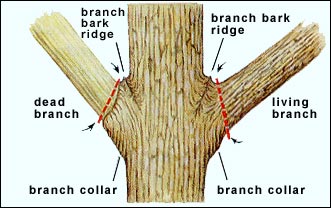
Proper pruning is important in maintaining the health of your tree. Trees have amazing natural defenses that enable them to heal – if they are pruned correctly. Cutting the tree improperly creates large wounds that leave the tree open to disease and decay. This is a quick introduction to proper pruning. It will show you how to make the right cut and gives some basic guidelines for making the decision to prune.
Tree branches grow outward from the main trunk of the tree (as opposed to a fork in the stem). When a tree branches, it forms a branch collar and a branch bark ridge. These two features are very important when it comes time to prune.
The branch collar is a distinctive bulge at the base of the branch, where it connects to the trunk. It is actually interlocking layers of cells of the branch and the trunk and is the part that will heal the wound left by pruning. The branch collar seals off the wound, minimizing disease and decay. Proper pruning leaves the branch collar intact. Branch collars vary widely from tree to tree, and from species to species. Some are large and very noticeable, while some are much harder to distinguish.
